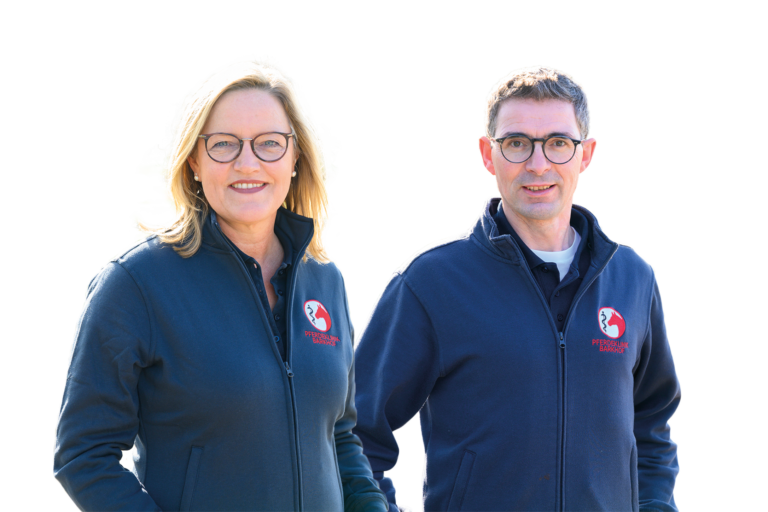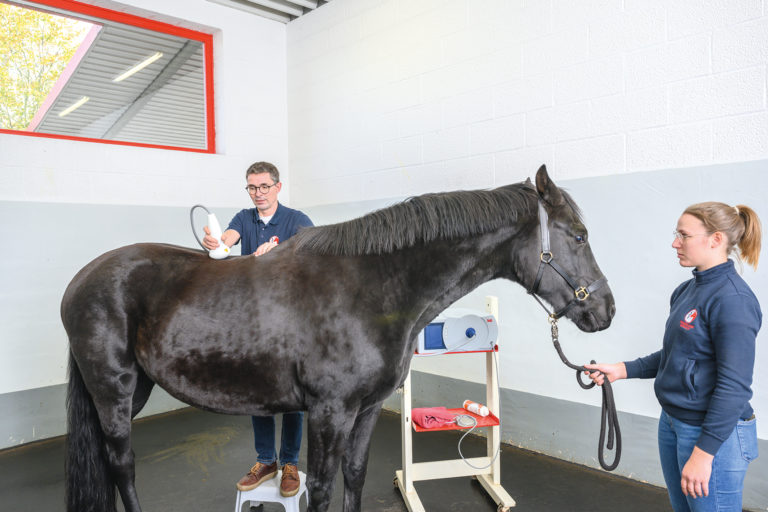
Sottrum, a Lower Saxon town and the nucleus of an eponymous association of local authorities in the district of Rotenburg (Wümme), is one of the leading centres for equine medicine in Germany – a reputation that dates back more than a quarter of a century. Indeed, the Pferdeklinik Barkhof celebrated its 25th birthday in 2018. “Not only do we give our all to ensure your horse enjoys the best possible medical care, we have also done our best since 1993 to ensure that you and your horse feel comfortable here,” emphasised Dr Jaugstetter at an open day to mark the milestone.
His entire team embodies this philosophy every day. Horse owners certainly feel assured they are in good hands from the moment they walk into the bright, freshly renovated reception area. A warm welcome awaits, not only from the friendly staff but also from Barkie, the hospital’s mascot – a horse skeleton that the staff presented to Dr Heinz Jaugstetter when he took over as director. The petite customer café is also immensely popular.
Features promoting the wellbeing of horses at the hospital include the four hectares of land surrounding the facility, with pastures available to the hospital’s patients. “Just so long as their condition permits,” says Jaugstetter, qualifying this perk. Patients who belong to more robust, hardy breeds and are rarely used being housed in box stalls are predominantly accommodated in the hospital’s spacious paddocks. What’s more, the hospital gives almost all its four-legged patients outdoor exercise – except those prescribed absolute box stall rest, of course. In addition to classic treatment approaches, the range of therapies to promote wellbeing also includes controlled treadmill exercise and physiotherapy.

The man responsible for the hospital’s holistic concept is Dr Heinz Jaugstetter, who became the director at Barkhof back in 2007. His message is emphatic. “We don’t just want to be a repair shop; we want to use our specialist expertise to help horses stay healthy,” he says. “In doing so, we build on the information provided by horse owners and work in trusting collaboration with them.” A father of two, Jaugstetter previously enjoyed success in the jumping saddle and now runs at least one international marathon per year. His philosophy eschews hierarchical systems, instead relying on teamwork and, in special cases, effective collaboration with specialised colleagues – most of whom are also regular speakers at the hospital.
They contribute to Barkhof-Fachakademie, a training academy set up at the hospital in 2008, which regularly holds recognised training and development events for veterinarians. The theme nights and seminars held under the motto “bleib gesund!” (stay fit!) are particularly popular. Targeted at horse owners and usually following the overarching theme of preventive care, these events aim to help keepers ensure their horses avoid becoming Barkhof patients in the first place.


The hospital treats horses, ponies and donkeys of all breeds. Though its primary clientele are sport horses – mostly warmbloods – Barkhof is increasingly seeing admissions of more robust, hardy breeds and geriatric horses in need of therapeutic care.
The holistic approach pursued at Pferdeklinik Barkhof is doubtless of benefit to patients in the latter category, as is the sensitive, caring approach taken towards owners. “We take a lot of time to discuss the clinical findings and highlight alternative therapy options,” says Dr Heinz Jaugstetter.
He does so in a meeting room equipped with two screens and a range of specimens to help discuss the findings. Beside the office building is an examination and treatment building with numerous rooms, including a well-equipped laboratory for diagnostic purposes, an in-house pharmacy and an operating theatre, complete with a pre-op and wake-up stall. The operating theatre is also directly adjacent to the special X-ray room, allowing anaesthetised horses to be transported directly for X-rays rather than via the stable aisle. The stable area and lunging hall also adjoin the building. The facilities’ design shows evidence of a long-term approach; everything is housed under one immense roof and, although the building spreads across 3,000 square metres in total, its various areas are well connected and can be reached quickly. Even outdoors, where a special loading stall has been created to minimise the animals’ stress, nothing has been left to chance. Drivers who have little experience manoeuvring trailers can drive a circuit around the hospital and thus avoid the stress of turning around in a confined car park.
“Around 70 per cent of Barkhof patients present with orthopaedic problems.”
“We don’t just want to be a repair shop, we want to use our specialist expertise to help horses stay healthy.”
One of the director’s areas of expertise is orthopaedics; with expertise in fields ranging from treating tendon injuries to osteosynthesis, Jaugstetter is often called on as a specialist consultant. Around 70 per cent of Barkhof patients present with orthopaedic problems. The hospital also offers extensive rehabilitation services. In addition to physiotherapy and the opportunity to exercise on a treadmill offering adjustable speed and incline settings – and which also allows the staff to perform endoscopies during exercise – Barkhof also offers magnetic field therapy, laser therapy, light therapy, shockwave therapy and stem cell therapy. A set of equine scales is also installed in the gynaecological examination stall, while the ultrasound examination stall is equipped with a vibration plate.

Our services for you:
The Barkhof team is made up of four vets – some of whom also travel to make patient visits – as well as six veterinary assistants, three staff members responsible for administration and stable management, plus a further three dedicated to caring for the Barkhof’s four-legged clients. The hospital also uses a special tool to keep a close eye on horses that have recently undergone surgery. The system monitors vital signs around the clock for two days following an operation and, if any changes are detected, raises the alarm. State-of-the-art technology and a warm, welcoming atmosphere: the Pferdeklinik Barkhof combines the two elements perfectly.
1. Veterinarians
4
Specialists with internationally recognised (European / US) qualifications
–
Specialists with national qualifications
–
Veterinarians, assistant veterinarians
4
2. Veterinary technicians and horse grooms with additional medical training
3
Trainees
+ 4
3. Horse grooms
3
4. Administrative staff
3
5. Other staff
–
6. Box stalls
39
Normal equine box stalls
30
Padded box stalls
2
Box stalls for mares with foals
4
Isolation box stalls
3
7. Examination / treatment rooms
4
8. Operating rooms
3
For procedures on standing horses
1
For procedures on lying horses
2
9. Paddocks
7
10. Pastures
3
11. Horse walker
–
12. Other
Horse trainer (treadmill)

4
internationally recognised veterinary surgeons in different areas of expertise take care of the four-legged patients
Weighting of the specialist areas for Equine Hospital Barkhof
Soft tissue surgery
Weighting: 21 to 50%
Equine soft tissue surgery primarily relates to abdominal/colic surgery and operations in the region of the urinary system, the sexual organs, and the upper and lower respiratory tracts, as well as operations on the skin.
Orthopaedic surgery
Weighting: 51 to 80%
Orthopaedic surgery is surgery on the musculoskeletal system of a horse. This includes operations relating to the bone skeleton, such as fracture fixation. It also includes endoscopic and arthroscopic procedures on joints, bursae and synovial sheaths, as well as operations on ligaments and tendons.
Orthopaedic diagnostics & therapy
Weighting: 81 to 100%
The field of orthopaedic diagnostics & therapy deals with musculoskeletal diseases and disorders, particularly relating to lameness.
Dentistry
Weighting: 51 to 80%
Dentistry involves prophylactic examinations of teeth and the oral cavity as well as the diagnosis and treatment of dental diseases and associated diseases of the paranasal system.
Internal medicine
Weighting: 51 to 80%
The specialist field of internal medicine subsumes a number of subareas and deals with the diagnosis and treatment of diseases of the internal organs. These include diseases of the gastrointestinal tract, the respiratory system, the urinary system, the blood and blood-forming organs, the muscles, the nervous system and the skin, plus hormonal and metabolic disorders and all infectious diseases.
Cardiology
Weighting: 21 to 50%
Cardiology is a separate specialty within the field of internal medicine and concerns the diagnosis and treatment of cardiovascular diseases and disorders, including cardiac arrhythmias, valve disorders, myocardial and pericardial disease and congenital cardiac malformations.
Intensive care and emergency medicine
Weighting: 51 to 80%
Intensive care and emergency medicine involves administering first aid in serious emergencies as well as providing care to and monitoring horses and foals with life-threatening illnesses. This also includes post-operative care to patients in need of intensive care.
Sports medicine
Weighting: 21 to 50%
Sports medicine entails the diagnosis and treatment of performance-related diseases and illnesses in sport horses and workhorses. Special dynamic examination methods are often used in this field, including performance tests, endoscopy during exercise, kinetic and kinematic gait analysis, and saddle pressure measurements.
Rehabilitation medicine
Weighting: 21 to 50%
The field of rehabilitation medicine is concentrated on recovery following surgical procedures, medical movement therapy to treat back pain and abnormal posture, and improving the quality of life of animals suffering from debilitating diseases such as arthritis or neurological impairments.
Ophthalmology
Weighting: 1 to 20%
Ophthalmology deals with diseases and functional disorders of the eyes, their adnexa, and the optic nerve up to the visual cortex in the brain – the visual processing centre. Ophthalmologists also perform surgical procedures on eyes.
Anaesthesia
Weighting: 21 to 50%
The specialist field of anaesthesia is concerned with professionally sedating and anaesthetising horses and sparing them unnecessary pain. Thanks to state-of-the-art methods and gentle techniques, it is now possible to perform complicated surgical procedures and life-saving emergency operations on seriously injured or sick horses and to transport them safely.
Diagnostic imaging
Weighting: 21 to 50%
Diagnostic imaging is the process of examining a horse using digital X-ray technology, ultrasound, computed tomography (CT), magnetic resonant imaging (MRI) and scintigraphy. Nowadays, many of these diagnostic techniques do not require general anaesthesia and can be performed on a standing horse.
Field service
Weighting: 81 to 100%
Veterinarians in field service provide emergency and primary healthcare to horses where they live. Modern field service providers possess a variety of mobile tools and equipment, allowing them to perform some in-depth examinations and treatments on-site.
Weighting of the specialist areas: range of services offered compared with the maximum service spectrum in the corresponding area.
Equine Hospital Barkhof
Siemensstrasse 4, 27367 Sottrum-Barkhof
